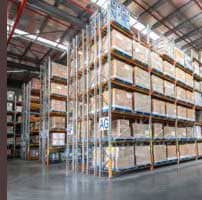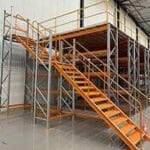Table of contents
- What’s ‘PA Qu’?
- ‘PA Qu’ in Warehouses
- Technical Documentation and CAD Design:
- Configuration Warning :
- Racking Consequences Section
- Racking Maintenance Reminder
- Conclusion on PA qU warehouse racking
- Next Steps
- Frequently Asked Questions
- Understanding Pallet Racking Weight Capacity
- What are the typical weight capacities for different pallet racking systems?
- Implementing PA Qu in Your Warehouse
- Getting Started with Total Racking Systems
Hey there! Do you know how your kids’ room gets messy with toys and how awesome it feels to put them away on shelves? Well, big warehouses do the same with boxes, and they use something called pallet racking – super strong metal shelves.
But here’s a cool thing – there’s a smart new way they’re figuring out how to make those metal shelves just right, not too weak and not too strong, and it’s called ‘PA Qu.’
What’s ‘PA Qu’?
Think about all your toys. Some are heavy, like your giant dinosaur, and some are light, like a feather. Now, if you had to make a shelf to hold all your toys, you wouldn’t make it so strong that it could hold a hundred dinosaurs unless you really had that many, right?
‘PA Qu’ is kind of like deciding to make a shelf that’s perfect for your average toy weight. If your toys are usually not super heavy, you don’t have to use a lot of wood to make a super-duper strong shelf. That saves wood and makes your room neater!
‘PA Qu’ in Warehouses
Warehouses are like giant rooms with lots and lots of boxes. They used to make all their metal shelves thinking every box was as heavy as the heaviest one, but that’s like always carrying your heaviest backpack for one heavy book. It’s too much!
Now they use ‘PA Qu’ to think about how heavy the boxes are usually, and they make the shelves strong enough for that. It’s smarter because it saves metal, and the shelves are just the perfect strength.
Specific Weight Capacity Numbers:
You know how some of your toy bins can hold your little LEGO pieces, but you need a stronger box for your big blocks? Warehouses work the same way! A typical pallet rack spot can hold two pallets of about 900kg each, making it 1,800kg total – that’s like parking a small car at every shelf level! When you use PA Qu, you get to figure out exactly how strong your shelves need to be for your particular boxes.
Load Capacity Labeling Information:
Just like how we put labels on your toy boxes so you know which one has dinosaurs and which has cars, PA Qu helps warehouses put important labels too! We make sure big, clear signs are placed at eye level on the first beam of each shelf unit. That way, the forklift drivers can easily see how much weight they can safely put on the shelves – just like knowing not to put all your heavy books on one wobbly shelf in your room!
Frame Types and Their Capacities:
PA Qu works with all sorts of different shelf strengths – just like how you might have plastic shelves for light toys and stronger wooden ones for heavier stuff. Our warehouse shelves come in different strengths too:
- Standard-duty frames that can hold up to nine tonnes (that’s like 150 kids!)
- Medium-duty frames that hold about 15 tonnes (like a school bus!)
- Heavy-duty frames with maximum loads of 20 tonnes (as heavy as a big dinosaur!)
Technical Documentation and CAD Design:
Remember how you use pictures to plan out your LEGO builds? PA Qu works the same way with special CAD drawings and the amazing ColbySURE program (formerly Rackman)! This super-smart system creates detailed plans showing exactly how your shelves should be set up to hold all your boxes safely. It’s like having the perfect instruction manual for your warehouse, designed by engineering experts! Each design even comes with a special ColbySURE certification letter that guarantees your shelves will be safe and sturdy.
Regulatory Compliance Section:
Just like how there are rules in school to keep everyone safe, warehouses have special safety rules too! Our PA Qu approach with ColbySURE makes sure all the rules are followed perfectly. The program automatically checks that your racking system will meet or exceed the Australian Standard AS 4084-2023 requirements.
The ColbySURE certification helps warehouse owners fulfil their important responsibilities to keep everyone safe. Plus, the warehouse still needs to have clear signs showing how much weight the shelves can hold. It’s like having a safety chart for your playground equipment that everyone can understand!
Racking weight load Calculation Example:
Let’s see how PA Qu works with a fun example! Imagine if your warehouse usually stores boxes weighing around 600kg per pallet instead of the maximum 900kg. Our super-smart ColbySURE program would calculate a shelving solution that’s just right for your 600kg average – not too strong and not too weak.
Here’s what a ColbySURE report might tell us for a typical warehouse setup:
- Rack with 8 bays
- Beam clear entry of 2590 mm (that’s about as wide as a small car!)
- Frame height of 5475 mm (taller than a giraffe!)
- Three storage levels at heights of 1800 mm, 3600 mm, and 5400 mm
- Each level designed to hold 2000 kg (that’s as much as two small cars!)
The program checks everything to make sure it’s safe, giving scores that need to be less than 1.0 (kind of like getting an A+ on a test). It’s like choosing the perfect-sized backpack for your school books instead of always carrying around the biggest one possible!
Configuration Warning:
Here’s an important thing to remember: moving the shelves around without checking if it’s safe is like rearranging the furniture in your room but forgetting to make sure your bookshelf won’t tip over! With PA Qu and the ColbySURE program, any changes to your warehouse shelves are carefully checked by professional engineers to make sure everything stays super safe. The ColbySURE certification is like a special safety badge that guarantees your racking system meets and often exceeds the safety standards in AS 4084-2023 (that’s the special rule book for warehouse shelves in Australia!).
Weight Distribution Importance
Spreading your weight evenly is super important! Think about how you need to put the heavier books at the bottom of your bookshelf so it doesn’t tip over. PA Qu does the same thing for warehouses – it makes sure the weight is spread out evenly so nothing gets too heavy in one spot. Our calculations look at not just how much stuff you’re storing, but exactly where and how you’re storing it!
Racking Consequences Section
Do you know what happens if you put too many books on a small shelf? It breaks! The same thing happens in warehouses, but it can be really dangerous and cost a lot of money. If warehouse shelves collapse, it can cost businesses over $150,000 in damages and lost work time – that’s enough money to buy thousands of ice creams! But with PA Qu, you’ll never have to worry about that happening.
Racking Maintenance Reminder
Even the best toy needs to be checked sometimes to make sure it’s still working properly, right? The same goes for warehouse shelves! Our Audit and Repair service includes a special schedule to check all your shelves regularly, making sure everything stays safe and works properly year after year. It’s like having a special toy doctor who comes to make sure all your toys are in tip-top shape!
Why Is This So Cool?
Using ‘PA Qu’ is awesome because it helps warehouse people save money and make everything safer. They know the shelves are just right – not too wobbly and not too bulky. It’s like when you pick the right size backpack for your school books, so your back doesn’t hurt.
And here’s a cool part – we use a special computer program called ColbySURE for warehouses. It’s a super smart tool that helps us figure out just how strong the shelves need to be and how much stuff you can put on them. Just like a video game that helps you organise your toys in the best way, ColbySURE helps warehouses keep all their boxes safe and sound!
Conclusion on PA qU warehouse racking
In conclusion, the introduction of ‘PA Qu’ to the world of warehouse organisation is a game-changer, mirroring the simplicity and efficiency we all appreciate when tidying up a child’s playroom but on a grand industrial scale. This innovative approach ensures that pallet racking systems are optimised for the average weight they will hold, striking the perfect balance between strength and material use. Not only does this mean significant cost savings for warehouses, but it also enhances safety and sustainability by preventing over-engineering and waste.
Don’t let your warehouse lag in the past with outdated, inefficient, and potentially unsafe racking solutions. Contact Total Racking Systems today to embark on a journey towards implementing the most efficient, safe, and tailor-made racking solutions. With our expertise and the power of ColbySURE, we will ensure your pallet racking is “just right” for all your boxes, saving you money, enhancing safety, and promoting sustainability. Make the smart move for your warehouse and reach out to Total Racking Systems now. Let’s work together to make your warehouse space efficient and safe.
Next Steps
- Learn More: Read our article on Calculate Pallet Rack weight capacity , Guide to Warehouse Racking Load Capacity or How to choose the best size, height and load rating for your pallet racking system
- Get a Quote: for Sydney pallet racking or learn how to Order pallet racking.
- Reach Out: For more information or assistance, contact Total Racking Systems.
- Schedule a Sydney warehouse assessment
Frequently Asked Questions
Understanding Pallet Racking Weight Capacity
What is PA Qu and how does it benefit warehouse organiSation?
PA Qu is an innovative approach to warehouse organisation that optimizes pallet racking systems based on the average weight they will hold rather than designing for maximum possible load. This creates a perfect balance between strength and material usage, resulting in cost savings, enhanced safety, and improved sustainability by preventing over-engineering and waste of materials.
How do I calculate my pallet racking weight capacity?
To calculate your pallet racking weight capacity, use this formula:
Maximum load per pair of beam × Frame load = Pallet racking capacity
And to determine your total number of layers:
Frame load ÷ Maximum load per pair of beams = Total number of layers
What factors affect pallet racking weight limits?
Several factors affect pallet racking weight limits:
- Bay clear entry width (distance between vertical beams)
- Beam depth (measured across the top of the beam)
- Beam face depth (varies from 80mm to 150mm)
- Racking beam section type (box beams vs. open beams)
- Racking frame size (height x width measurements)
- Vertical beam pitch (height of each storage level)
- Upright duty classification (heavy, medium, or standard duty)
- Number of beam levels per bay and beam spacing Steel quality and thickness (gauge)
- Manufacturer’s specific design specifications
What are the typical weight capacities for different pallet racking systems?
For standard pallet racking:
- Standard-duty frames: typically carry nine tonnes
- Medium-duty frames: usually hold 15 tonnes
- Heavy-duty frames: have a maximum load of 20 tonnes
- A typical pallet rack compartment can hold two pallets, each weighing 900 kg on a pair of beams
In Australia, standard pallets can carry between 500kg – 1,800kg, while steel pallets can hold approximately 2,000kg.
What happens if I exceed the pallet racking weight limit?
Exceeding the pallet racking weight limit can lead to:
- Collapse of the racking system
- Injury to staff and visitors, potentially resulting in lawsuits
- Expensive repairs that could have been prevented
- Fines for failing to comply with industry safety standards
- Extended downtime as you replace equipment and stock
Where should load capacity information be displayed?
Load capacity information should be clearly displayed on:
- Safe Working Load capacity signs (SWL) placed on the first beam elevation, positioned at eye level
- Labels on each bay (most common method)
- Rack load capacity signs positioned at the end of aisles and in tunnels (when rack design is consistent throughout the warehouse)
What are the Australian standards for pallet racking?
In Australia, the standard AS 4084-2023 outlines requirements for steel storage racking including:
- Ensuring correct application and use of racks
- Maintaining safe workloads
- Verifying that installed racking has not been altered
- Procedures for inspecting racks to ensure safety
What happens if I reconfigure my pallet racking system?
If rack beam levels are changed, added, or removed, that new configuration needs to be certified by a qualified engineer, documented with updated technical drawings, and kept on hand for reference. Changes to your rack configuration can directly impact load capacity limits.
Implementing PA Qu in Your Warehouse
How does the ColbySURE program work with PA Qu?
ColbySURE is a specialised computer program that works with the PA Qu approach to determine the optimal strength requirements for warehouse shelving. It analyzes the specific needs of your warehouse to calculate how strong your racking needs to be and how much weight it can safely hold, preventing both under-engineering and over-engineering of your storage solutions.
How can PA Qu save money for my warehouse?
PA Qu saves money by:
- Optimising material usage for racking (using only what’s needed)
- Preventing overbuilding of racks for loads they’ll never carry
- Reducing the risk of accidents and associated costs
- Creating more efficient space utilisation
- Facilitating proper weight distribution throughout the warehouse
- Extending the life of your racking system through appropriate use
How do I transition my warehouse to a PA Qu system?
To transition to a PA Qu warehouse racking system:
- Contact Total Racking Systems for a consultation
- Have your current inventory and storage needs assessed
- Get a customised racking plan using the ColbySURE program
- Implement proper weight capacity labelling and staff training
- Ensure all documentation including technical drawings are updated and properly displayed
What makes PA Qu different from traditional racking calculations?
Traditional racking calculations often assume maximum possible weight for all storage needs, resulting in overbuilt and costly systems. PA Qu takes a more nuanced approach by analyzing the actual average weights your warehouse typically stores, creating “just right” solutions that are neither too weak nor unnecessarily strong. This approach is more economical, sustainable, and tailored to your specific warehouse needs.
Getting Started with Total Racking Systems
How can I get a customised racking solution for my warehouse?
Contact Total Racking Systems today for a consultation. Our team will assess your specific storage needs, analyse your typical loads, and design a custom pallet racking system using the PA Qu approach and ColbySURE program to ensure your racking is “just right” for your requirements.
Does Total Racking Systems provide installation and maintenance services?
Yes, Total Racking Systems provides comprehensive services including:
- Custom design of pallet racking systems
- Professional installation
- Regular maintenance programs
- Safety inspections
- Repairs and upgrades as needed
- Documentation and compliance support
How quickly can Total Racking Systems implement a new racking solution?
The timeline for implementing a new racking solution depends on the size and complexity of your warehouse. Contact our team today for a consultation to receive a personalised timeline for your project.
How do I ensure my staff is properly trained to use the PA Qu system?
Total Racking Systems offers comprehensive training programs for warehouse staff to ensure they understand weight capacity limits, how to read load capacity labels, and how to safely utilise your new or optimised racking system. This training is essential for maintaining a safe and efficient warehouse environment.





